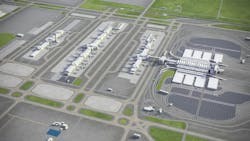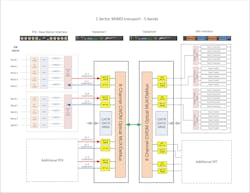Managing Cellular Connectivity Challenges During the Holiday Season
Each year, the busy Holiday season is a wakeup call for airport operators in charge of providing ubiquitous cellular connectivity to support staff, customers and the many other amenities expected of a modern facility. Given the growing reliance and importance of digital technologies such as mobile ticketing and wayfinding apps, robust wireless has quickly become the “fourth utility” for airport operations alongside running water, electricity, and heating/cooling systems.
However, providing wireless in all airport sectors for hundreds of thousands to millions of people a day is becoming increasingly challenging with the growing complexity of networks and the sophistication of the use cases they are designed to support. As the wireless generation moves from 4G/LTE to 5G, many airports are looking to upgrade but it’s important to do so in such a way that is simplified and easy to manage.
The Growing Complexity of Cellular Connectivity in Airports
The reason providing adequate wireless connectivity is more difficult today is the convergence of three significant realities.
More Wireless-enabled Services
The first is the increasing number of services and applications in airports that rely on connectivity to function compared to the recent past. Before, it was about providing excellent mobile phone service and now modern U.S. airports leverage wireless for parking and electric
vehicle charging, hi-def screens and information kiosks, self-service kiosks, mobile passenger checkpoints, enhanced mobile communication capabilities for visitors, contactless purchasing, mobile wayfinding, interdepartmental staff communication, baggage tracking, asset control and monitoring, and more. Airports have significantly more bandwidth needs, which strains even the most advanced cellular networks.
Increasingly Fragmented Wireless Networking Ecosystem
The second reality is the growing complexity of the wireless ecosystem with the introduction of 5G and private networking. While passengers and staff simply expect wireless “to work,” making it happen is much more nuanced. The big three U.S. mobile carriers, Verizon, AT&T and T-Mobile, use multiple radio frequency (RF) bands to transport 4G and 5G. For example, T-mobile primarily uses 2.5GHz and 600MHz to support their 5G offering, while 1900 MHz, 850 MHz, 1700/1200MHz is used for 4G/LTE. This is conceptually the same for Verizon and AT&T as well albeit with more bands and different frequency slices. The complexity is doubled since every communication band in modern wireless coverage operates in MIMO (multiple inputs multiple outputs) that essentially doubles each of the antenna’s signals.
In addition to supporting all 4G/LTE and 5G bands for the carriers, airports may also invest in private networks to provide connectivity for its most sensitive operations. Private networks utilize unlicensed or “lightly licensed” spectrum such as the Citizens Broadband Radio Service (CBRS) and are ideal for highly confidential operations or low latency applications. This is due to the networks being under complete airport control, making them more secure and allowing an operator to have greater control of bandwidth allocation for differing use cases.
Finally, operators must also support public safety communication for first responders, which leverages a different set of RF bands from the commercial deployments mentioned above. This can be AT&T’s nationwide network FirstNet (700MHz) and/or others like UHF/VHF depending on the region. This is all to say the sheer number of RF bands being transported to disparate locations creates complexity.
Providing Ubiquitous Cellular Coverage to Large Areas
The last reality is the huge surface area of most U.S. airports that must receive both coverage and capacity. For example, the largest airport in the United States, Denver International Airport, is 52.4 square miles. Sometimes, operators don’t just need to cover every terminal, runway, parking garage, outdoor area, etc. but also assume wireless responsibility for the emergency services like hotels, emergency care, and fire stations in close proximity.
Improving Management of Wireless Networks
Managing all wireless infrastructure and connections can be challenging, which is why airports are beginning to use new techniques to help simplify their approach to handling these massive networks. But first it’s important to discuss how indoor networks are generally deployed.
Since RF signals from macro networks (e.g., traditional antenna tower or roof deployment with an approximated line of sight to the expected user’s space) struggle to propagate through man-made obstacles such as concrete, metals, LEED-certified glass and more, airports often deploy distributed antenna systems (DAS) to bring that connectivity indoors. A standard DAS in-building network has a signal source, whether that is a small cell or base transceiver station (BTS) connecting to a DAS head end (HE), which then distributes the RF bands to a certain number of remote units (RU) that grow in number depending on coverage needs (i.e. multiple floors, corridors, etc.). The RUs then transport the signal to many antennas built into often discreet locations within the structure as specified during the network design process. All this disparate DAS equipment requires a lot of cabling and passive components to connect.
The size of these deployments grows in correlation to the facility size. In airports, a single BTS is required for each sector of DAS deployment and some terminals require more than ten sectors each! Within each sector, most or all the frequency bands must be transported if an airport wants to support 4G/LTE and 5G for all mobile carriers – and doubled since it is MIMO. Consider all terminals (arrivals and departures), parking garages, runways, administrative offices, baggage areas to fully understand the difficulty in managing these connections.
Remoting the BTS to help Organize the Chaos: Using Service-agnostic RFoF
With all the dispersed infrastructure including the plethora of BTS required to supply connectivity to an airport, it is a huge cost and risk to have them on or near the airport site. To combat this challenge, RF over fiber (RFoF) is being used by airports to improve management of the network. RFoF is a technology that transmits radio frequency (RF) signals over optical fiber cables. RFoF transfers the signals without any content processing like a coaxial cable but doing so over fiberoptic cable can extend the range by five miles or more. While more expensive than coaxial cabling, it provides a more resilient and high-quality signal over longer distances and can carry more data across a single fiber.
RFoF can significantly extend the distance between a BTS and DAS head end, enabling all the BTS’s that would otherwise be dispersed around the airport to be placed in a single centralized offsite location. This not only saves resources by making it easy for a single technician to be responsible for any issues should they happen, but it also frees up valuable airport space, which is at a premium. RFoF also reduces the amount of cabling, capable of transporting 6 RF bands for two MIMO sectors (4 bi-directional signal flows, plug ethernet if/when required) over single fiber (Figure 3) using a 3U rack stack at each end. Considering the number of BTS, DAS head ends and remotes that must distribute multiple bands for all carriers, this significantly reduces overall cabling costs.
As airport operators grapple with the higher stakes of supplying excellent cellular connectivity, they must also take it a step further and think about how they can best control all of these communication systems over time as simply and cost effectively as possible. While operators can’t control the many 4G/LTE, 5G and private networking RF bands required to support the future of airports, they can control the simplicity in the way it is managed using RFoF.
About the author:
Meir Bartur, Ph.D, is the President & CEO of the Optical Zonu Corporation. Dr. Bartur has over 30 years of experience in leadership, product development, and technology innovation. As a Senior Member of the IEEE and recognized leader in the development of low-cost fiber optic solutions for FTTx, he contributed both to the IEEE ITU PON standards. Before founding Optical Zonu, he directed Advanced Product Development and Strategic Technology for access transceivers at MRV Communications’ (MRVC), as well as business relations with its major clients. Prior to that, he held posts as VP of Engineering & Technology at SSDI (Solid State Devices Inc), VP of Engineering at MEC (Molecular Electronics Corp), and systems engineering Captain in the Israeli Air Force.
About the Author

Meir Bartur
Meir Bartur, Ph.D, is the President & CEO of the Optical Zonu Corporation. Dr. Bartur has over 30 years of experience in leadership, product development, and technology innovation. As a Senior Member of the IEEE and recognized leader in the development of low-cost fiber optic solutions for FTTx, he contributed both to the IEEE ITU PON standards. Before founding Optical Zonu, he directed Advanced Product Development and Strategic Technology for access transceivers at MRV Communications’ (MRVC), as well as business relations with its major clients. Prior to that, he held posts as VP of Engineering & Technology at SSDI (Solid State Devices Inc), VP of Engineering at MEC (Molecular Electronics Corp), and systems engineering Captain in the Israeli Air Force.



